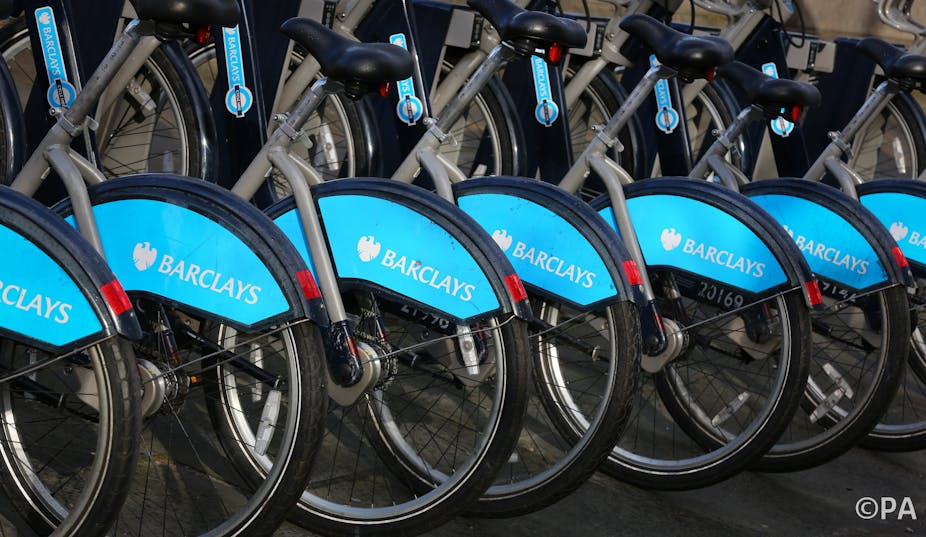London’s cycle hire scheme has become a prominent fixture in the capital’s transport network since it opened in 2010. Known as “Boris Bikes”, it is Barclays Bank that has provided commercial sponsorship for the scheme from the beginning, a relationship that is due to end in 2015. So the search is now on for a successor with deep pockets, one that is willing to play a role in shaping the future of the scheme.
Many bike hire schemes begin small, with the number of bikes initially in the hundreds rather than thousands. But in London, helped by a swelling population of more than 8m people and the support of the city mayor, the scheme opened with 5,000 bikes and has gradually expanded to 11,200. It is now the second largest scheme in Europe, after Paris. The financial support pledged by Barclays (£25m over five years) was certainly a factor that enabled the scheme to open at this scale.
The end of 2013 saw a decline in the number of journeys made, in comparison to the same period in 2011 and 2012, before picking up again in 2014 to hit a milestone of 30 million journeys. A study of the scheme’s users found they were disproportionately male and from more affluent areas of the city. Hopefully this issue will be addressed by the extension of the scheme to other parts of London, encouraging access to a wider spectrum of the city’s population.
For many schemes, including London’s, private sponsorship is an important element of the business model. JCDecaux and Clear Channel (both outdoor advertising companies) are involved in many European schemes. They typically manage the scheme and supply capital for the start-up and running costs in exchange for rights to a proportion of the advertising boards across the city. The London scheme differs here in that the sponsor’s investment provides advertising of their brand, as opposed to increasing the share of the market they operate in.
For London, this external sponsorship is vital – Transport for London are looking for £37.5m – and the scheme has not yet shown to be profitable. As Barclays withdrew their financial support, the scheme’s expansion into southwest London in 2013 was taxpayer funded. Nearby councils were reported to have jointly paid around £4m towards the £10m cost.
Schemes have sometimes relied upon an individual to champion the policy and ensure its success, especially in the early days of a scheme. London mayors Ken Livingstone and Boris Johnson have had important roles for London, but a champion will continue to be needed to prevent the scheme from faltering.
As the London cycle hire scheme reaches a crossroads, what can be learnt from other schemes? The Paris scheme is seen as a great success but it relies upon high user numbers to offset the expense of sustaining it. Smaller schemes – for example those run by Nextbike– offer a greater likelihood of financial sustainability, but lower running costs are a key factor in this. Crucially, in many cities cyclists benefit from wider roads and more defined space. In contrast, one of the most pressing issues for London is the safety of cyclists, which is a problem for the city as a whole, including those using the bike hire scheme.
Busy, narrow roads and insufficient or absent cycling infrastructure dissuade many from using the scheme. Data suggests that a London hired bike is used far less frequently over the course of a day than a bike would be in many schemes elsewhere. Infrastructure problems are seen as a key factor in this, and this raises the issue of value for money. Resolving the safety and infrastructure problems are of course not easy tasks, and real change in authorities’ attitudes towards cycling is occurring very slowly. But concerted effort and change here may well be the key to reigniting the initial success of the scheme.
The importance of a suitable sponsor for the scheme cannot be underestimated as their financial support will be essential. Public funding will undoubtedly continue to be needed but to a lesser extent if the scheme prospers. It has been contested that Barclays’ decreasing interest in the scheme may be the result of the growing cycling safety issues in London. This is perhaps the most difficult hurdle that the scheme, and whoever its new sponsor will be, must overcome in coming years. Bikes that aren’t used are no use to anyone, whoever pays for them.

